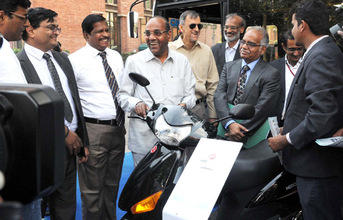
Anant Geete inaugurated the display of electric vehicles with the launch of newly approved Government scheme FAME
At an event organised by the Department of Heavy Industry (DHI), Government of India, in association with the Society of Indian Automobile Manufacturers (SIAM), at the India Habitat Centre, New Delhi, Union Minister of Heavy Industries and Public Enterprises, Anant Geete, launched FAME, which is a scheme for Faster Adoption and Manufacturing of (Hybrid and) Electric Vehicles in India.
In 2011, the then Union Cabinet had approved the setting up of a National Mission on Electric Mobility (NMEM) with two apex bodies under it, the National Council on Electric Mobility (NCEM) at the Ministerial level and the National Board on Electric Mobility (NBEM) at the Secretary level to formulate the road map for a new paradigm in road transportation centering around hybrid and electric vehicles.
Referring to these apex bodies, Geete said that post a detailed field level study, a consumer survey by a reputed global knowledge partner, and a number of meetings between NCEM and NBEM showed that electric mobility can become a prominent theme for DHI. The 12th Five Year Plan also approved an outlay of 795 crore for the same.
Based on the road map prepared by the DHI, a National Electric Mobility Plan (NEMMP-2020) was released in January 2013 by the then Prime Minister. The NEMMP 2020, drawing on various inputs received from all concerned stake holders including different Ministries, the Planning Commission, the industry and academia, laid down an aspirational target of 6-7 million hybrid and electric vehicles per year by 2020. This is subject to commensurate incentives extended by the Government for demand and supply creation, technology and research and development projects, creation of public charging infrastructure, and pilot projects. The industry on its part is also expected to make substantial investments based on this long term vision plan.
End



























